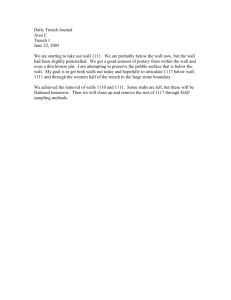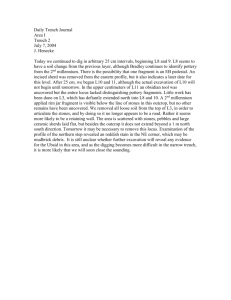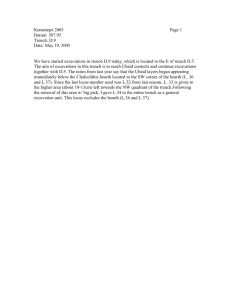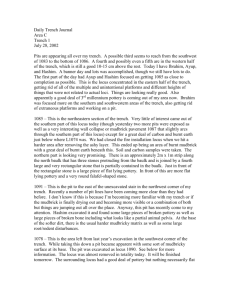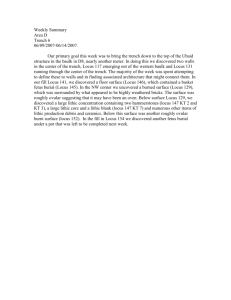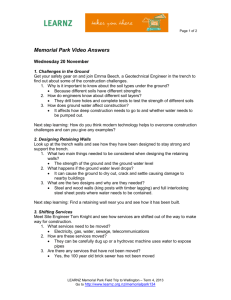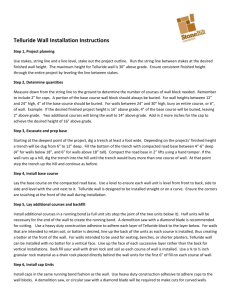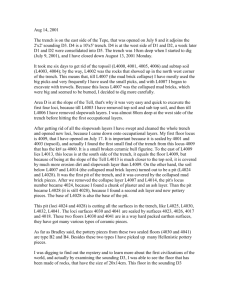Kenan Tepe Area F Trench 22 Trench Summary Andy Creekmore
advertisement
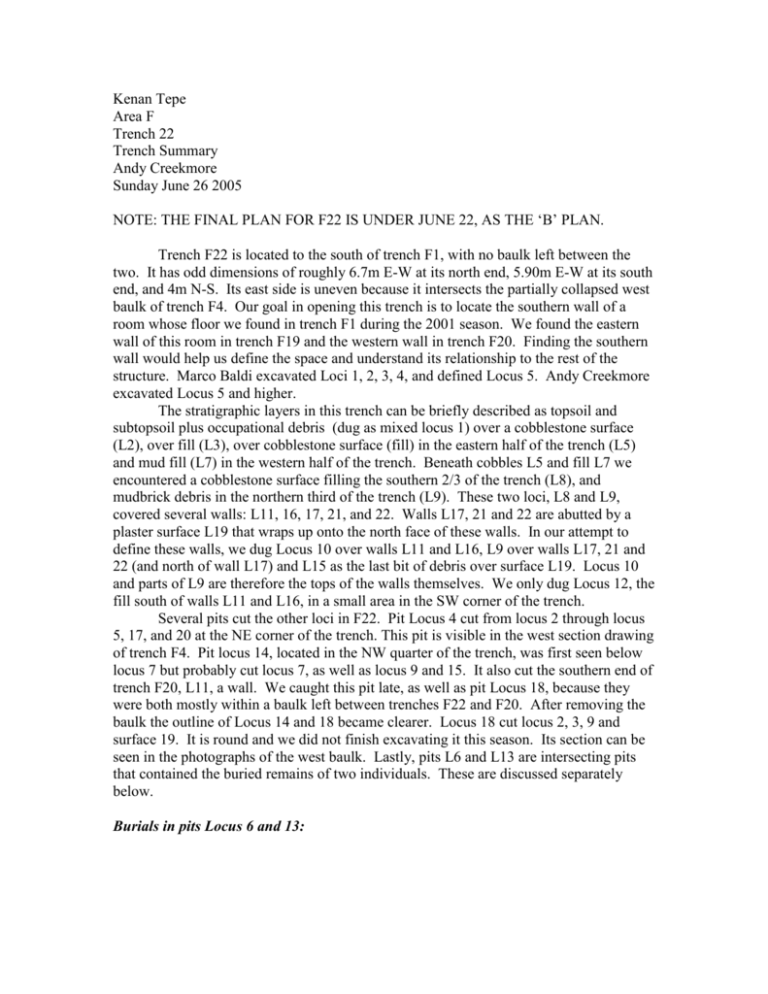
Kenan Tepe Area F Trench 22 Trench Summary Andy Creekmore Sunday June 26 2005 NOTE: THE FINAL PLAN FOR F22 IS UNDER JUNE 22, AS THE ‘B’ PLAN. Trench F22 is located to the south of trench F1, with no baulk left between the two. It has odd dimensions of roughly 6.7m E-W at its north end, 5.90m E-W at its south end, and 4m N-S. Its east side is uneven because it intersects the partially collapsed west baulk of trench F4. Our goal in opening this trench is to locate the southern wall of a room whose floor we found in trench F1 during the 2001 season. We found the eastern wall of this room in trench F19 and the western wall in trench F20. Finding the southern wall would help us define the space and understand its relationship to the rest of the structure. Marco Baldi excavated Loci 1, 2, 3, 4, and defined Locus 5. Andy Creekmore excavated Locus 5 and higher. The stratigraphic layers in this trench can be briefly described as topsoil and subtopsoil plus occupational debris (dug as mixed locus 1) over a cobblestone surface (L2), over fill (L3), over cobblestone surface (fill) in the eastern half of the trench (L5) and mud fill (L7) in the western half of the trench. Beneath cobbles L5 and fill L7 we encountered a cobblestone surface filling the southern 2/3 of the trench (L8), and mudbrick debris in the northern third of the trench (L9). These two loci, L8 and L9, covered several walls: L11, 16, 17, 21, and 22. Walls L17, 21 and 22 are abutted by a plaster surface L19 that wraps up onto the north face of these walls. In our attempt to define these walls, we dug Locus 10 over walls L11 and L16, L9 over walls L17, 21 and 22 (and north of wall L17) and L15 as the last bit of debris over surface L19. Locus 10 and parts of L9 are therefore the tops of the walls themselves. We only dug Locus 12, the fill south of walls L11 and L16, in a small area in the SW corner of the trench. Several pits cut the other loci in F22. Pit Locus 4 cut from locus 2 through locus 5, 17, and 20 at the NE corner of the trench. This pit is visible in the west section drawing of trench F4. Pit locus 14, located in the NW quarter of the trench, was first seen below locus 7 but probably cut locus 7, as well as locus 9 and 15. It also cut the southern end of trench F20, L11, a wall. We caught this pit late, as well as pit Locus 18, because they were both mostly within a baulk left between trenches F22 and F20. After removing the baulk the outline of Locus 14 and 18 became clearer. Locus 18 cut locus 2, 3, 9 and surface 19. It is round and we did not finish excavating it this season. Its section can be seen in the photographs of the west baulk. Lastly, pits L6 and L13 are intersecting pits that contained the buried remains of two individuals. These are discussed separately below. Burials in pits Locus 6 and 13: NOTE: THERE IS A SECOND, ‘B’ DAY PLAN ON JUNE 14 AND 15 THAT CONTAINS SKETCHES OF THE LOCATIONS OF SELECTED BONES AS THEY WERE REMOVED. Pit Locus 13 is the larger disturbed area that may have been created during the original burial of individual 1. Pit Locus 6, which stretched the disturbance further to the west, may have resulted from the burial of individual two. The burials consisted of individual 1 (I1), interred first, and individual two (I2), added at a later time. I1 is a nearly complete articulated skeleton, including the right arm, wrist, and hand, some ribs, the pelvis, both legs and the right foot. This individual is lying on its back with its legs flexed and knees rolled to the left, or north. The knees stuck up in the air considerably, perhaps confined to a small pit, and were clipped a bit by baulk cutting/erosion in F1. The left arm was found out of proper position, below and around the cranial vault, which was also displaced. It seems likely that the sequence of events that formed L6 occurred as follows: I1 was interred within a pit. Later I2 was being buried when the diggers disturbed burial one’s left arm and skull. They placed these bones, along with those of I2, on top of and beside the skull of individual one. I2 was either disarticulated to begin with, or buried in a very tightly compacted flexed position. The former seems more likely because most or all of its mandible is missing, along with its pelvis, wrist, ankle and toes. Only a small piece of a mandible was found and without further analysis we cannot say if it belongs to I1 or I2. The crania of I1 and I2 were found lying back to back, the top of each head to the SW, with crania 1 (to the east) facing SE, and crania 2 (to the west) facing NW. The atlas (1st) vertebra was found stuck to crania 1. We found a bronze (?) pin near the pelvis of I1 (but some 10cm higher) but is likely dislocated from its original position. During its recovery we bent the tip of the pin (L6, KT1). It has a ball head, is pierced below the head, and has a considerable weight. Both I1 and I2 are adults although we have not yet made any determination of sex or age. It is my feeling that these burials date no later than the Middle Bronze Age, and are probably Early Bronze Age. The pin should help bracket the time of burial. These burials may be contemporary with those found in F1 and excavated as L1021A/B. Those burials were also interred one on top of the other, the latter disturbing the former, and they also contained grave goods consisting of a pot and perhaps a spindle whorl (the whorl may not belong to the burial). Spatially the F1 and F22 burials were very close together, have only about 20cm difference in their elevation, and they are oriented along the same E-W axis. It is possible that the F1 L1021 A/B and F22 L6 burials were intentionally placed in/over the room formed by the walls found in F19, F20 and F22. NOTE: we found a lithic, L6 KT4, just east of and adjacent to the right arm (radius/ulna) of Individual 1. This lithic appears to be an unmodified flake and could derive from the burial fill, but given its location it could also be a grave good. A juglet was found in nearly the same position in F1 burial L1021. NOTE: all the bones for individual 1 and individual 2 were given Locus 6, KT 1 because of the mixing of bones near the head of individual 1. During a future inventory of the skeletons the bones of individual two should be given a new KT number. Architectural Summary/ Interpretation of F22: My current interpretation of the architecture in F22 is that abutting, E-W walls L11 and L17 formed a double wall, perhaps for two abutting structures. In the eastern baulk (west baulk of F4) the visible foundations of L17, L20, abut the north face of L11, indicating that L17 was built after L11. It may have been built later in the same week or year or later over a longer period. My feeling is that L17 was built not long after L11. Walls L16 and L21 are also E-W abutting walls that continue the path of L11 and L17. The space between L17 and L21 is filled or blocked by a wall stub, L22, which forms a passageway with the southern end of the F20 wall, L11. Locus 22 may have blocked another passageway from the south, or it’s apparent separation from L17 and 21 may simply reflect architectural practices. The baked mud plaster surface L19 connects F20 L11 to F22 L17, 21 and 22 because it wraps up onto the southern face of F20 L11 and the north face of the F22 walls. This surface is the same one found in F1 during the 2001 season, and in F19 this season. After the walls L11, 16, 17, 21 and 22 were in ruin (perhaps collapsing in part into trenches F1 and F19), a fill of cobblestones, L8, was placed over these walls and fill L12 to the south. It is clear that L8 was an intentional fill because it is thicker to the south, over L12, which would have been more deflated then the nearly two meter thick, solid brick walls to the north. That is, the fillers had to put a thicker layer of cobblestones in the south to fill in the depressed area but not so many above the stubs of the walls L11, 16, and such. The relative lack of cultural material in L8 suggests that it was a ‘clean’ fill of cobblestones brought from the river bed or eroding layers on the river bank, rather the scavenged from around the inhabited area. The source of loci 2, 3, 5, and 7 may have been additional attempts to fill in the area or to create activity surfaces to go with new structures yet to be discovered. Locus List for Trench F22: 1: topsoil: mix of several layers down to cobbles; no material collected. 2: layer of cobblestones; no material collected. 3: fill below cobblestones: cut by L4, L18 4: Bricky pit in NE corner, cuts 2, 5, 9, 17, 20. 5: Cobble and pebble feature in E ½ of trench 6: Burial cutting L13; two persons. 7: fill under L3, same levels as L5 but no cobbles 8: thick, larger cobblestone layer under L5, L7; filled in south side of wall L11 and covered the wall too. 9: catch all fill; north of wall L17 but also brick melt and tops of walls L11, 16, 17, 21, 22 as we defined these walls. 10: Fill/defining tops of walls L11, 16,17 11: E-W wall. 12: fill south of L11. 13: burial pit, cut by pit L6. 14: pit that cuts south end of trench F20, L11 (wall). 15: last bit of debris over floor L19. 16: E-W wall. 17: E-W wall. 18: pit in NW corner of trench, cuts L2, 3, 9, 19. 19: baked plaster surface abutting walls L17, 21, 22 and in F20 L11. 20: foundations of wall L17 21: E-W wall in NW corner of trench. 22: wall stub between wall L17 and L21. Forms doorway with F20 L11. F22TrenchSummary2005.doc
